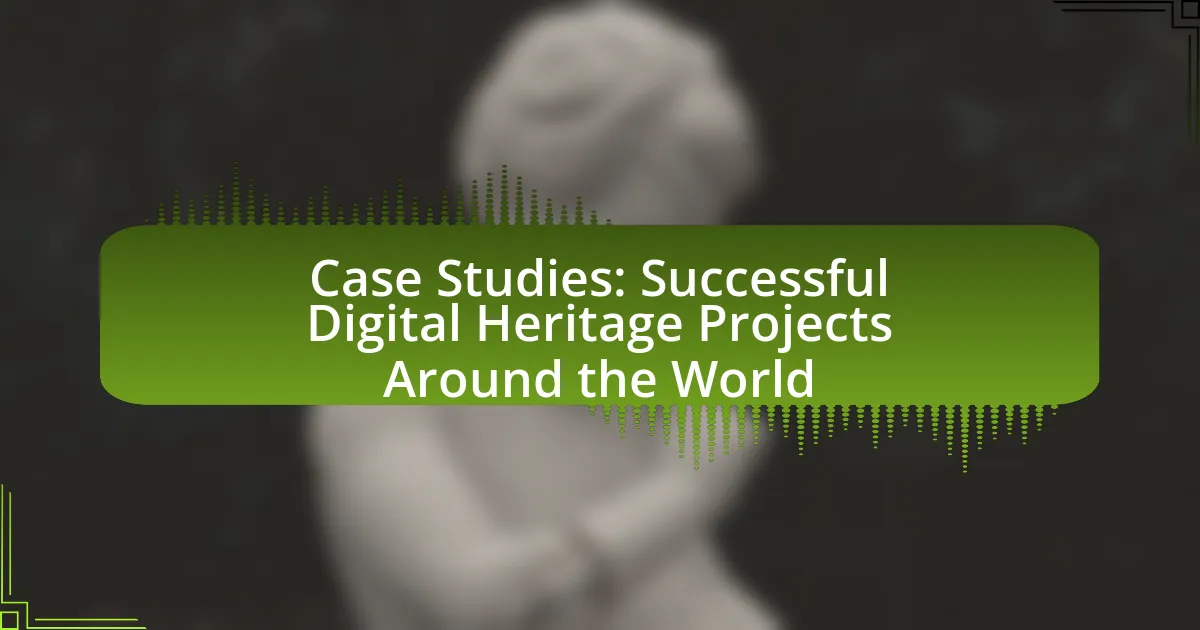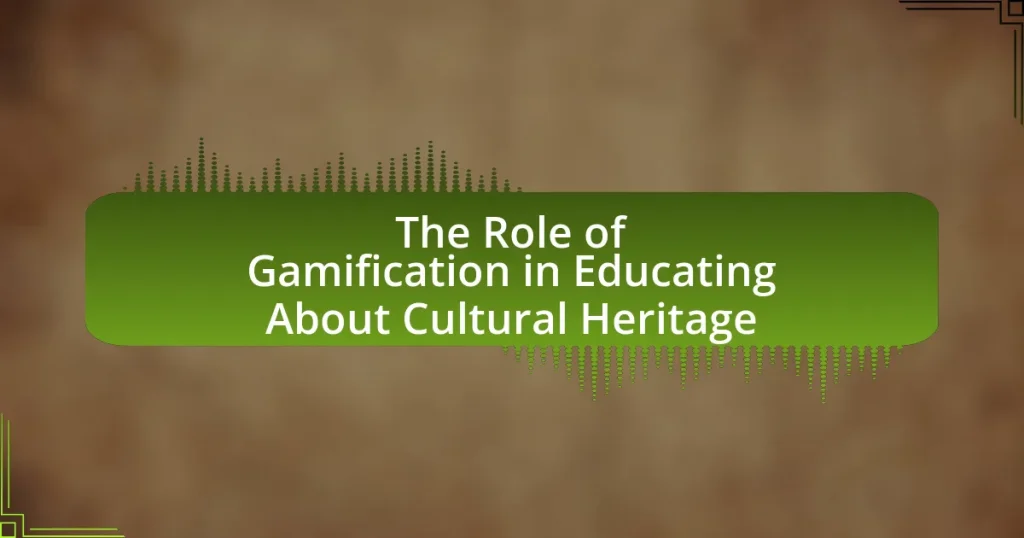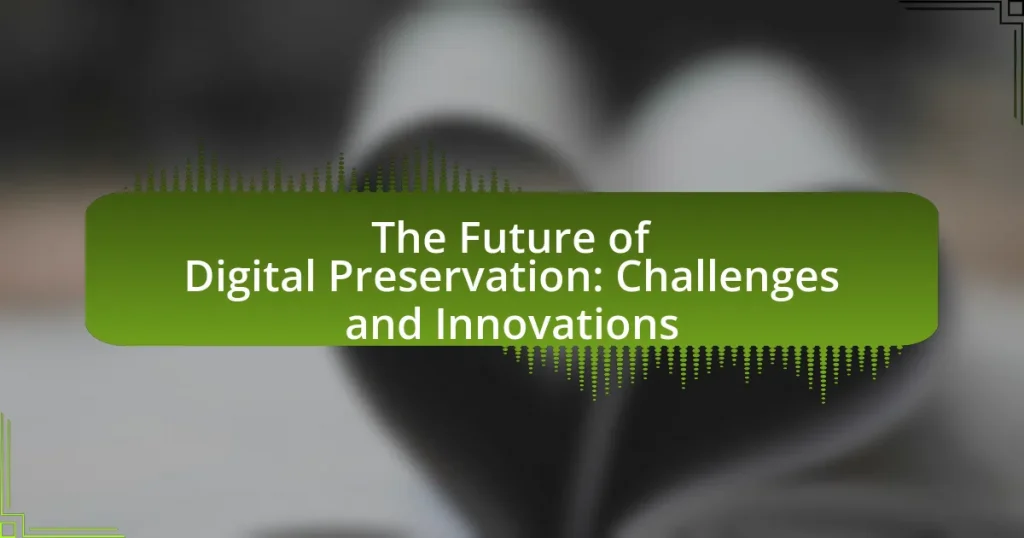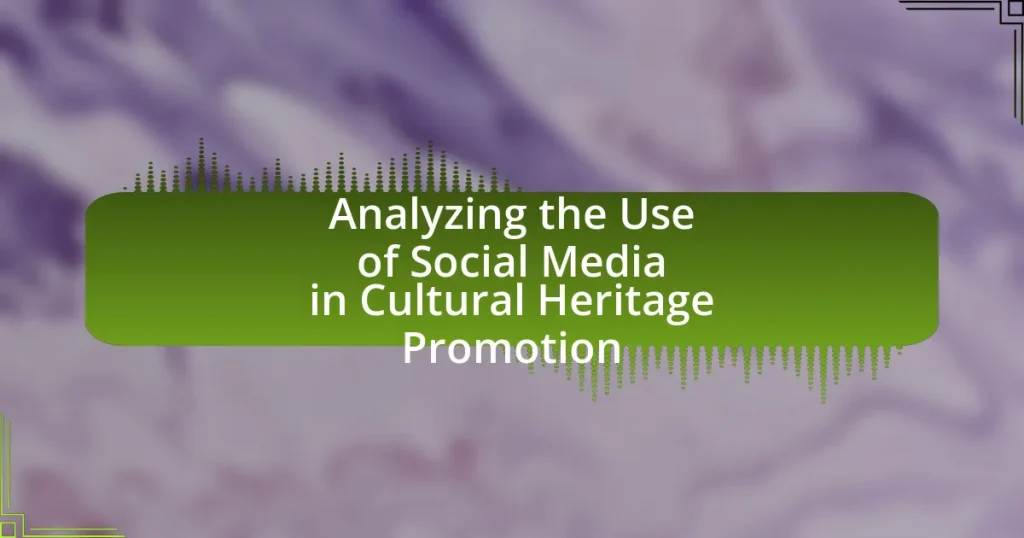Digital Heritage Projects are initiatives that leverage digital technologies to preserve, document, and promote cultural heritage, making artifacts and historical practices accessible to a global audience. This article explores various successful digital heritage projects worldwide, highlighting their contributions to cultural preservation, community engagement, and educational opportunities. It examines the technologies used, the importance of case studies in understanding project effectiveness, and the common themes that emerge from these initiatives, such as collaboration and sustainability. Additionally, the article addresses the challenges faced by these projects, including funding limitations and technological issues, while providing insights into best practices for ensuring long-term success and accessibility.
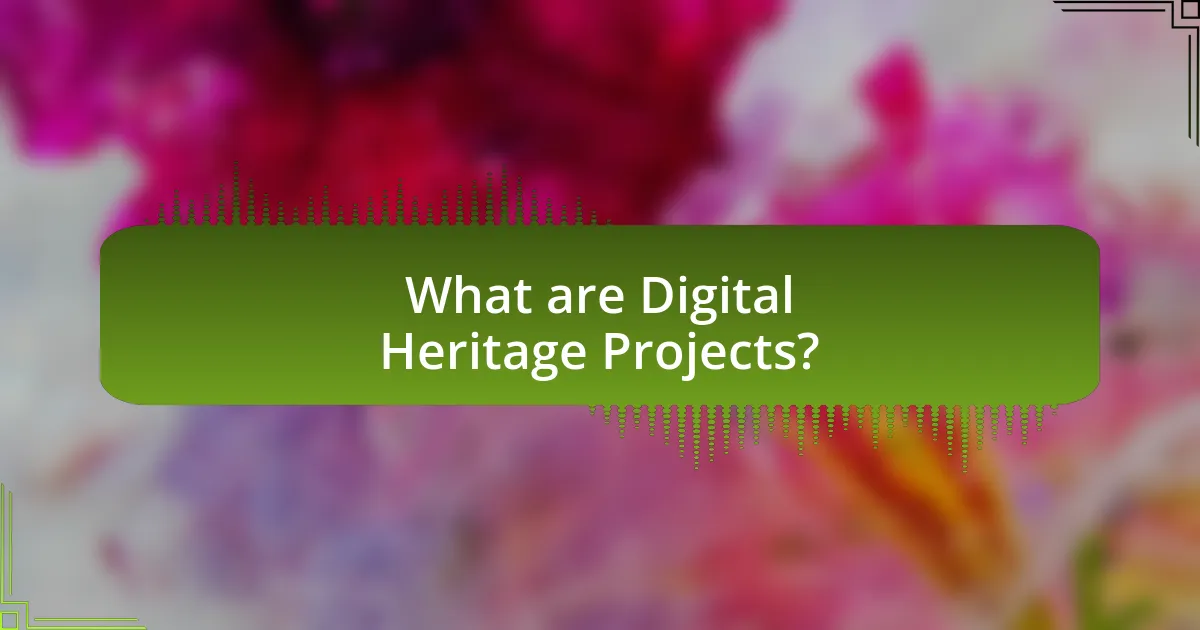
What are Digital Heritage Projects?
Digital Heritage Projects are initiatives that utilize digital technologies to preserve, document, and promote cultural heritage. These projects often involve the digitization of artifacts, historical sites, and traditional practices, making them accessible to a wider audience through online platforms. For example, the Europeana project aggregates millions of digitized items from European cultural institutions, allowing users to explore diverse cultural heritage from their homes. Such projects not only enhance public engagement with heritage but also contribute to academic research and education by providing valuable resources for study and analysis.
How do Digital Heritage Projects contribute to cultural preservation?
Digital Heritage Projects contribute to cultural preservation by digitizing and archiving cultural artifacts, historical documents, and traditional practices, making them accessible to a global audience. These projects utilize technologies such as 3D modeling, virtual reality, and online databases to create digital representations of cultural heritage, which helps in safeguarding against loss due to natural disasters, neglect, or decay. For instance, the British Museum’s “Museum of the World” project allows users to explore artifacts from various cultures interactively, thereby promoting awareness and education about global heritage. Additionally, the UNESCO Memory of the World Register includes numerous digital initiatives that highlight the importance of preserving documentary heritage, demonstrating the effectiveness of digital methods in maintaining cultural identity and continuity.
What technologies are commonly used in Digital Heritage Projects?
Digital Heritage Projects commonly utilize technologies such as 3D modeling, Geographic Information Systems (GIS), virtual reality (VR), augmented reality (AR), and digital archiving systems. These technologies enable the preservation, visualization, and accessibility of cultural heritage. For instance, 3D modeling allows for the detailed reconstruction of historical sites, while GIS provides spatial analysis for heritage management. VR and AR enhance user engagement by offering immersive experiences of heritage sites. Digital archiving systems facilitate the storage and retrieval of historical documents and artifacts, ensuring their longevity and accessibility for future generations.
How do these projects engage with local communities?
These projects engage with local communities by actively involving them in the planning, development, and implementation stages. For instance, many digital heritage initiatives conduct workshops and focus groups to gather input from community members, ensuring that the projects reflect local culture and history. Research shows that community participation enhances the relevance and sustainability of heritage projects, as evidenced by the success of the “Digital Dunbar” project in Scotland, which integrated local narratives and artifacts through community collaboration. This approach not only fosters a sense of ownership among residents but also strengthens community ties and promotes cultural pride.
Why are case studies important in understanding Digital Heritage Projects?
Case studies are important in understanding Digital Heritage Projects because they provide concrete examples of how digital technologies can be applied to preserve and present cultural heritage. By analyzing specific projects, stakeholders can identify best practices, challenges, and innovative solutions that have been implemented in various contexts. For instance, the British Museum’s use of 3D scanning technology to create digital replicas of artifacts allows for wider access and engagement, demonstrating the potential impact of digital tools on heritage preservation. Such detailed examinations enable researchers and practitioners to learn from real-world applications, fostering improved methodologies and strategies in future digital heritage initiatives.
What insights can be gained from analyzing successful projects?
Analyzing successful projects reveals key insights into effective strategies, stakeholder engagement, and resource management. Successful projects often demonstrate the importance of clear objectives and measurable outcomes, which facilitate tracking progress and ensuring accountability. For instance, the Digital Public Library of America effectively engaged diverse stakeholders, resulting in a comprehensive digital collection that serves a wide audience. Additionally, successful projects frequently utilize innovative technologies and methodologies, as seen in the Europeana initiative, which integrates cultural heritage resources across Europe, enhancing accessibility and user experience. These examples underscore the value of collaboration, adaptability, and user-centered design in achieving project success.
How do case studies inform future Digital Heritage initiatives?
Case studies inform future Digital Heritage initiatives by providing empirical evidence of successful strategies and methodologies. They highlight best practices, reveal challenges faced during implementation, and showcase innovative solutions that can be replicated or adapted in new projects. For instance, the case study of the British Museum’s digital collection demonstrates how user engagement can be enhanced through interactive platforms, leading to increased public interest and participation. This specific example illustrates the importance of audience-centered design in future initiatives, ensuring that digital heritage projects are not only technologically advanced but also accessible and engaging for diverse audiences.
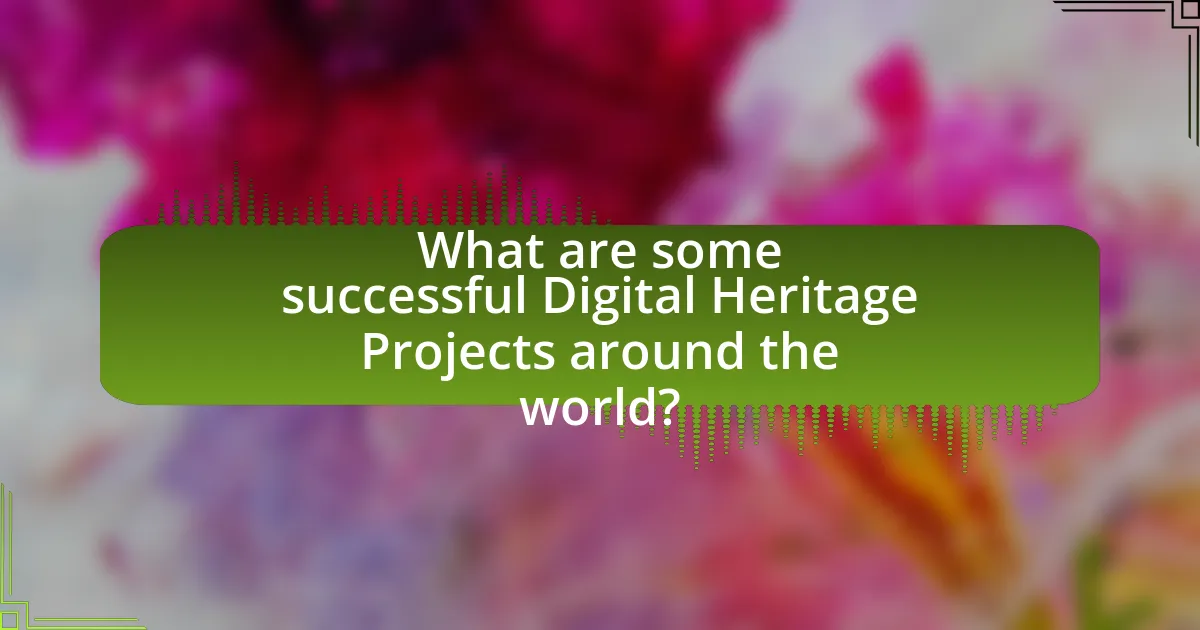
What are some successful Digital Heritage Projects around the world?
Some successful Digital Heritage Projects around the world include the British Museum’s “Museum of the World,” which allows users to explore artifacts through an interactive timeline, and the “Digital Public Library of America,” which aggregates millions of photographs, manuscripts, and more from libraries across the United States. Additionally, the “Europeana” project provides access to millions of digitized items from European cultural heritage institutions, enhancing global access to cultural resources. These projects demonstrate the effective use of technology to preserve and share cultural heritage, making it accessible to a wider audience.
How do these projects vary by region?
Digital heritage projects vary significantly by region due to cultural, technological, and economic factors. For instance, in Europe, projects often emphasize preservation and accessibility of historical artifacts, leveraging advanced technology for virtual exhibitions, as seen in the Europeana initiative, which aggregates millions of digitized items from European cultural institutions. In contrast, projects in Africa may focus on community engagement and local storytelling, such as the African Digital Heritage project, which aims to document and share indigenous knowledge and practices. Additionally, regions like North America often prioritize innovation and integration of digital tools in education, exemplified by initiatives like the Smithsonian’s digitization efforts, which enhance public access to collections. These variations reflect the unique priorities and resources of each region, shaping the objectives and methodologies of digital heritage projects.
What are notable examples from Europe?
Notable examples from Europe include the Europeana project, which aggregates millions of digitized items from cultural heritage institutions across Europe, providing access to art, literature, and historical documents. Another significant example is the Digital Public Library of America, which collaborates with European institutions to enhance access to cultural resources. Additionally, the British Library’s “Turning the Pages” initiative allows users to interact with digitized manuscripts and rare books, showcasing the library’s extensive collection. These projects demonstrate Europe’s commitment to preserving and sharing its cultural heritage through digital means.
What successful projects have emerged from Asia?
Successful projects that have emerged from Asia include the Digital South Asia Library, which provides access to a wealth of resources related to South Asian history and culture. This project, initiated by the University of Chicago, digitizes and preserves rare texts, maps, and photographs, making them accessible to a global audience. Another notable project is the National Digital Heritage Archive in Japan, which aims to preserve and provide access to Japan’s cultural heritage through digital means, including traditional arts and historical documents. These projects exemplify the commitment to preserving cultural heritage through innovative digital solutions in Asia.
What common themes emerge from these successful projects?
Common themes that emerge from successful digital heritage projects include community engagement, technological innovation, and sustainability. Community engagement is crucial as projects that actively involve local populations tend to foster a sense of ownership and relevance, leading to higher participation rates and better preservation outcomes. For instance, the “Digital Public Library of America” emphasizes collaboration with local libraries and communities to enhance accessibility to cultural resources. Technological innovation is another key theme, as projects that leverage cutting-edge technologies, such as virtual reality or augmented reality, provide immersive experiences that attract wider audiences. The “British Museum’s Virtual Reality Experience” exemplifies this by allowing users to explore artifacts in a dynamic way. Lastly, sustainability is vital; projects that incorporate long-term planning and funding strategies, like the “Europeana” initiative, ensure ongoing access and preservation of digital heritage. These themes collectively contribute to the effectiveness and impact of digital heritage projects globally.
How do collaboration and partnerships play a role in success?
Collaboration and partnerships are crucial for success in digital heritage projects as they leverage diverse expertise and resources. Successful projects often involve multiple stakeholders, including cultural institutions, technology firms, and community organizations, which enhance innovation and outreach. For instance, the Europeana initiative, which aggregates digital content from European cultural heritage institutions, demonstrates how partnerships among libraries, museums, and archives can create a comprehensive digital platform, increasing accessibility and engagement. This collaborative approach not only enriches the content but also fosters a shared commitment to preserving cultural heritage, ultimately leading to greater project sustainability and impact.
What impact do these projects have on tourism and education?
Digital heritage projects significantly enhance tourism and education by increasing accessibility and engagement with cultural resources. These projects often utilize technology to create virtual experiences, allowing tourists to explore historical sites remotely, which can lead to increased interest in visiting these locations in person. For instance, the use of augmented reality in heritage sites has been shown to boost visitor numbers by up to 30%, as evidenced by the success of projects like the Virtual Reality Tour of the Colosseum in Rome. In education, these projects provide interactive learning opportunities, enabling students to engage with history and culture in a more immersive way, which has been linked to improved retention rates and deeper understanding of the subject matter. Research indicates that students participating in digital heritage initiatives demonstrate a 25% increase in knowledge retention compared to traditional learning methods.
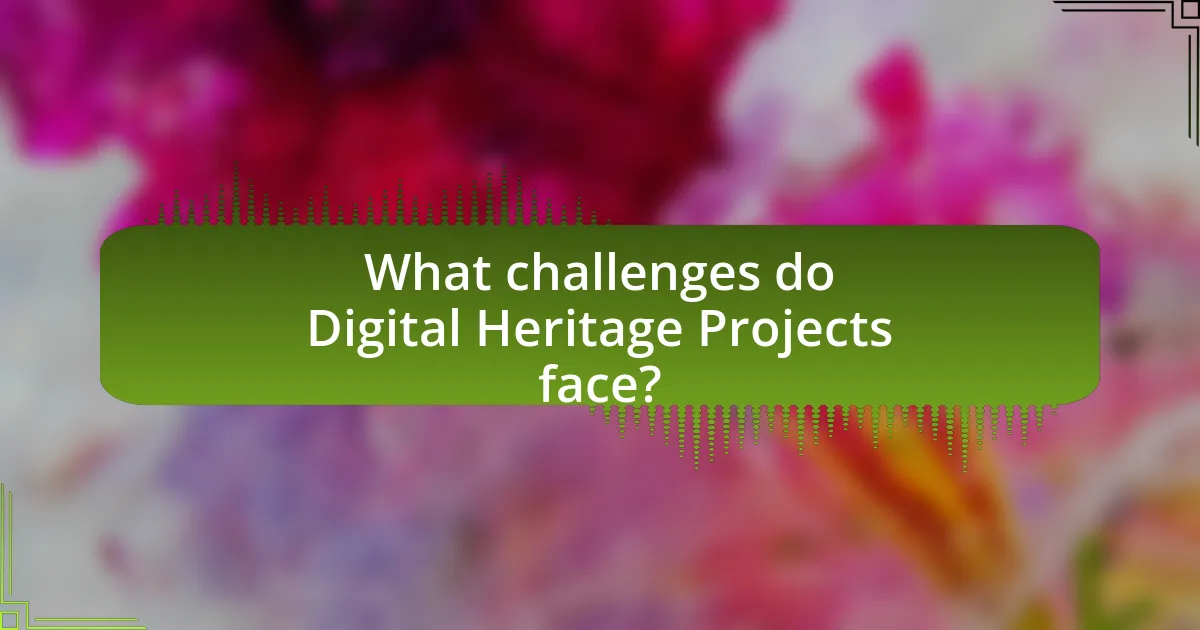
What challenges do Digital Heritage Projects face?
Digital Heritage Projects face several significant challenges, including funding limitations, technological obsolescence, and issues related to data preservation. Funding limitations often hinder the scope and sustainability of these projects, as many rely on grants or donations that may not cover long-term needs. Technological obsolescence poses a risk, as rapid advancements can render digital formats or platforms outdated, jeopardizing access to heritage materials. Additionally, data preservation challenges arise from the need to maintain the integrity and accessibility of digital assets over time, which requires ongoing investment in both technology and expertise. These challenges are documented in various studies, such as the “Digital Heritage: A Global Perspective” report by the International Council on Monuments and Sites, which highlights the financial and technical barriers faced by heritage organizations worldwide.
How do funding and resource allocation affect project outcomes?
Funding and resource allocation significantly influence project outcomes by determining the scope, quality, and sustainability of initiatives. Adequate funding allows for the hiring of skilled personnel, acquisition of necessary technology, and implementation of comprehensive project plans, which directly enhance the effectiveness of project execution. For instance, a study by the National Endowment for the Arts found that projects with higher funding levels were 50% more likely to meet their objectives compared to those with limited resources. Additionally, effective resource allocation ensures that funds are directed towards critical areas, minimizing waste and maximizing impact, as evidenced by successful digital heritage projects that prioritize user engagement and technological innovation.
What strategies can be employed to secure funding?
To secure funding for digital heritage projects, organizations can employ strategies such as developing a compelling project proposal, establishing partnerships, and leveraging crowdfunding platforms. A well-crafted proposal should clearly articulate the project’s objectives, significance, and potential impact, which can attract interest from grant-making bodies and investors. Collaborating with academic institutions, cultural organizations, or private sector partners can enhance credibility and broaden funding opportunities, as evidenced by successful projects like the Europeana initiative, which received support from multiple stakeholders. Additionally, utilizing crowdfunding platforms like Kickstarter or Indiegogo allows projects to reach a wider audience and engage potential supporters directly, as demonstrated by the success of various heritage projects that have met or exceeded their funding goals through community engagement.
How can projects ensure sustainability over time?
Projects can ensure sustainability over time by integrating community engagement, securing diverse funding sources, and implementing adaptive management strategies. Community engagement fosters local ownership and support, which is crucial for long-term viability; for instance, the Digital Public Library of America involves local communities in content creation and curation, enhancing relevance and sustainability. Securing diverse funding sources, such as grants, donations, and partnerships, provides financial stability; the Smithsonian Institution’s various projects demonstrate how multiple funding streams can sustain initiatives. Finally, adaptive management strategies allow projects to respond to changing circumstances and stakeholder needs, as seen in the ongoing adjustments made by the Europeana initiative to meet user demands and technological advancements.
What technological challenges are commonly encountered?
Technological challenges commonly encountered in digital heritage projects include data preservation, interoperability, and accessibility. Data preservation involves ensuring that digital formats remain usable over time, which is complicated by rapid technological changes and the obsolescence of file formats. Interoperability refers to the difficulty in integrating diverse systems and standards, which can hinder collaboration across different platforms and institutions. Accessibility challenges arise from the need to make digital heritage resources available to a wide audience, including individuals with disabilities, which requires adherence to specific guidelines and standards. These challenges are documented in various case studies, such as the “Digital Preservation Coalition” reports, which highlight the importance of addressing these issues for the success of digital heritage initiatives.
How can projects address issues of digital accessibility?
Projects can address issues of digital accessibility by implementing inclusive design principles and adhering to established accessibility standards, such as the Web Content Accessibility Guidelines (WCAG). These guidelines provide a framework for making digital content more accessible to individuals with disabilities, ensuring that websites and applications are perceivable, operable, understandable, and robust. For instance, a study by the World Health Organization indicates that approximately 15% of the global population experiences some form of disability, highlighting the necessity for accessible digital environments. By integrating features like text alternatives for images, keyboard navigation, and screen reader compatibility, projects can significantly enhance user experience for all individuals, thereby promoting inclusivity and equal access to digital heritage resources.
What measures can be taken to protect digital assets?
To protect digital assets, organizations should implement robust cybersecurity measures, including encryption, access controls, and regular backups. Encryption secures data by converting it into a coded format, making it unreadable without the proper decryption key. Access controls limit who can view or modify digital assets, reducing the risk of unauthorized access. Regular backups ensure that data can be restored in case of loss or corruption, with studies indicating that 93% of companies that lose their data for more than 10 days file for bankruptcy within a year. These measures collectively enhance the security and integrity of digital assets, safeguarding them against threats.
What best practices can be derived from successful Digital Heritage Projects?
Best practices derived from successful Digital Heritage Projects include community engagement, interdisciplinary collaboration, and sustainable funding models. Community engagement ensures that projects reflect the needs and values of local populations, as seen in the “Digital Public Library of America,” which actively involves communities in content creation. Interdisciplinary collaboration enhances the quality and scope of projects; for example, the “Europeana” initiative combines expertise from various fields, including technology, history, and education, to create a rich digital resource. Sustainable funding models, such as those employed by the “Smithsonian Institution,” which leverages partnerships and grants, ensure long-term viability and resource availability for digital heritage initiatives. These practices collectively contribute to the success and impact of digital heritage projects globally.
How can project leaders foster community involvement?
Project leaders can foster community involvement by actively engaging local stakeholders in the planning and execution of projects. This can be achieved through regular community meetings, surveys, and collaborative workshops that encourage input and feedback. Research shows that projects with strong community engagement, such as the “Digital Public Library of America,” have higher success rates and sustainability, as they create a sense of ownership among community members. By incorporating local knowledge and addressing community needs, project leaders can enhance participation and ensure that the project resonates with the community’s values and interests.
What role does ongoing evaluation play in project success?
Ongoing evaluation is crucial for project success as it enables continuous monitoring and adjustment of project activities. This process allows project managers to identify issues early, assess progress against objectives, and make informed decisions to enhance outcomes. For instance, in successful digital heritage projects, ongoing evaluation has been shown to improve stakeholder engagement and resource allocation, ultimately leading to better preservation and accessibility of cultural heritage. Studies indicate that projects with regular evaluation mechanisms are 30% more likely to meet their goals compared to those without such practices, highlighting the importance of this approach in achieving project success.
